Living Cultural Infrastructure as a Model for Biocultural Conservation: A Case Study of the Maekha Canal, Chiang Mai, Thailand
Abstract
1. Introduction
1.1. Background of the Study
1.2. Site Profile: Maekha Canal and Its Role in Chiang Mai’s Socio-Cultural and Ecological Landscape
1.3. Current Challenges: Pollution, Habitat Degradation, and Loss of Traditional Knowledge
1.4. Conceptual Framework
- Participatory Design: Grounded in co-creation principles, to ensures that urban green spaces are culturally resonant and ecologically appropriate by directly involving stakeholders. A core tenet of this approach is civic ecology, where communities actively manage their landscapes.
- Biocultural Stewardship: This approach centers on the active role of the community in the care, maintenance, and interpretation of their intertwined biological and cultural heritage. It emphasizes local agency in preserving place-based knowledge and practices, ensuring that the landscape’s living heritage is managed sustainably by and for the community.
- Cultural Ecosystem Services (CESs): Finally, the framework incorporates CESs to account for the critical intangible benefits, such as recreation, spiritual value, and sense of place, that are often neglected in conventional urban planning.
1.5. Research Objectives
- To investigate and document traditional and evolving plant-based knowledge and practices among communities along the Maekha Canal, with a focus on cultural, medicinal, and ecological uses.
- To engage local residents in a participatory co-design process to create an interpretive urban ethnobotanical trail that reflects community values, plant heritage, and site-specific ecological narratives.
- To develop a model for community-led biocultural stewardship that integrates cultural ecosystem services, supports biodiversity conservation, and strengthens the cultural identity of the canal corridor.
2. Materials and Methods
2.1. Study Area
2.2. Ethnobotanical Survey and Data Collection
- Informant Selection: A purposive and snowball sampling strategy was employed to recruit 20 key informants (12 female, 8 male) aged between 45 and 82. Initial contact was made through a community leader, who then recommended other knowledgeable individuals. Selection criteria included a minimum of 20 years of residency in the canal-side communities and recognition by peers as having deep knowledge of local flora. This group comprised local elders, traditional healers, and community gardeners.
- Field Methods and Data Collection: The survey employed a combination of semi-structured interviews and free-roaming transect walks along the 3.5km study area. This approach aimed for an exhaustive inventory of culturally significant plants identified by informants, rather than systematic plot surveys. Interviews were conducted in the local Northern Thai dialect, averaged 45-60 min, and took place at locations chosen by the informants. The open-ended interview protocol focused on plant names, uses (medicinal, culinary, ritual), parts utilized, preparation methods, and associated oral histories. Theoretical saturation was considered to have been reached when interviews with new informants ceased to yield new plant species or significant use categories. All interviews were audio-recorded with permission.
- Botanical Identification: Plant species identified during interviews were documented photographically. For species requiring further identification, voucher specimens were collected, assigned a collection number, and identified using regional botanical keys. The identification was subsequently verified by specialists at Chiang Mai University, where specimens are deposited.
2.3. Participatory Co-Design Process
- Participant Recruitment: An open invitation was extended to the broader community through local networks and public posters to mitigate self-selection bias. This resulted in the participation of a diverse group, including local artisans, youth group members, informal vendors, and other interested residents.
- Workshop Structure: Three primary co-design workshops were held, each lasting approximately three hours. The workshops utilized visual tools such as large-scale maps, photographs of the documented plants, and drawing materials. Facilitated discussions focused on co-developing the trail’s narrative themes, prioritizing locations for interpretive “learning points,” and brainstorming features for the trail. To manage conflicting expectations, a consensus-building approach was used, where facilitators helped the group find common ground and prioritize ideas that served the broadest community benefit.
2.4. Data Analysis
- Qualitative Analysis: Interview recordings were transcribed and translated. The transcripts were then analyzed using a thematic coding approach in NVivo software. An initial open coding process was conducted by two researchers independently to identify emergent themes. The inter-coder reliability was checked through discussion to resolve discrepancies before the codes were finalized and grouped into the 13 ethnobotanical use categories presented in the results.
- Quantitative and Geospatial Analysis: The plant inventory data was summarized to determine the dominant families and growth forms. The ethnobotanical use data was structured to generate the chord diagram (Figure 4), visualizing the relationships between plant families and use categories. Georeferenced photographs and field notes were used to map the spatial distribution of key plant species and cultural sites along the canal corridor.
2.5. Ethical Considerations and Informed Consent
3. Results
3.1. Plant Inventory
3.2. Usage Patterns
“For small, everyday injuries, or when the children are playing and get a little scrape, you don’t need to go to the medicine cabinet. [Pointing to the Bitter bush, (Chromolaena odorata)] Just crush this up to stop the bleeding. The old people taught us that the plants along the canal are our medicine cabinet. We have to keep this knowledge alive for our children and grandchildren.”—Female community elder, 68
“For the past thirty years, our houses turned their backs to the canal. It was just a backyard, overgrown and a place nobody wanted to look at. Since these workshops started, we have begun to turn back around. Now, we are designing its future. The same old canal is making us happier than before; it’s a place we can be proud of.”—Male community leader, 55
3.3. Trail Design Output
- Living Interpretation and Interpretive Media: The most significant design feature is the establishment of a “community storyteller” program, where trained local guides share firsthand knowledge. To support this, illustrative guides for the “Walk Along” eco-tours were developed, providing visual information on local flora and fauna (Figure 6B).
- On-Site Learning Points: The trail incorporates designated stops that use diverse media to convey information. These include clear botanical signage for identifying local plant species (Figure 6A) and vibrant, co-designed community art murals that serve as large-scale visualizations of the area’s significant flora (Figure 6C).
- Data-Driven Educational Tools: The on-site experience is underpinned by extensive data collection, which has been translated into accessible educational materials. These range from detailed ethnobotanical maps showing the spatial distribution of plant types (Figure 6D) to analyses of the canal’s floral biodiversity, which can be used in schools and community workshops (Figure 6E).
4. Discussion
4.1. Reclaiming Urban Biocultural Space
4.2. The Role of Community in Co-Producing Urban Space
4.3. Biocultural Stewardship as a Regenerative Practice
4.4. Challenges, Limitations, and Adaptive Management
4.5. Future Opportunities
- Integration into Learning Ecosystems: A primary avenue for impact lies in integrating the trail into formal and informal learning ecosystems. The trail’s rich dataset, including the 149 documented species and their 13 cultural use categories, offers an ideal platform for experiential “living classroom” activities. For local schools, this could involve interdisciplinary modules where science students conduct seasonal phenology observations and social studies students document oral histories from the “community storytellers.” For the wider community, the trail provides a venue for workshops on topics such as herbal medicine or sustainable urban gardening, co-facilitated by local elders and experts, thereby reinforcing stewardship and the role of landscape architects as co-producers of pedagogical urban landscapes.
- A Transferable Model for Urban Regeneration: Beyond its immediate context, the project offers a transferable methodology for biocultural regeneration adaptable to other urban waterways in Thailand. This approach can be contrasted with other prominent revitalization projects, such as the Khlong Ong Ang walking street in Bangkok. While the Khlong Ong Ang project successfully improved landscape aesthetics through a top–down, municipally-led initiative, the Maekha model emphasizes a bottom–up, co-production process centered on ethnobotanical knowledge and stewardship. Successful replication of the Maekha model, therefore, demands a focus on process, not form. Key enabling conditions for adaptation include (1) the presence of strong social capital and an existing grassroots network; (2) willing institutional partners from municipal or local governments; (3) a community with rich, accessible local ecological knowledge; and (4) a collective commitment to long-term stewardship over short-term aesthetic outcomes.
- Informing National Policy Frameworks: The ‘Living Cultural Infrastructure’ model can be embedded within national frameworks for green urbanism and cultural heritage. To make this actionable, specific policy recommendations can be formulated. For instance, municipal land-use regulations could be amended to recognize ‘biocultural corridors’ as a specific zoning category, protecting them from generic development. Furthermore, national urban development funds could allocate resources specifically for community-led stewardship programs, providing for long-term maintenance and programming. Finally, participatory ethnobotanical assessments could be institutionalized as a required step in the planning process for any revitalization project in historically significant urban areas, ensuring that cultural knowledge is integrated from the outset.
4.6. Limitations of the Study
5. Conclusions
Author Contributions
Funding
Data Availability Statement
Conflicts of Interest
References
- Wang, Y.; Chang, Q.; Fan, P. A framework to integrate multifunctionality analyses into green infrastructure planning. Landsc. Ecol. 2021, 36, 1951–1969. [Google Scholar] [CrossRef]
- Koc, C.B.; Osmond, P.; Peters, A. Towards a comprehensive green infrastructure typology: A systematic review of approaches, methods and typologies. Urban Ecosyst. 2017, 20, 15–35. [Google Scholar] [CrossRef]
- Liu, Y.; Ge, H. Exploration of the Cultural Heritage Distribution Along the Beijing-Hangzhou Grand Canal and Its Implications: A Case Study of Cultural Relics Protection Units in the Jiangsu Section. Sustainability 2024, 16, 11248. [Google Scholar] [CrossRef]
- McLain, R.; Poe, M.; Hurley, P.T.; Lecompte-Mastenbrook, J.; Emery, M.R. Producing edible landscapes in Seattle’s urban forest. Urban For. Urban Green. 2012, 11, 187–194. [Google Scholar] [CrossRef]
- McLain, R.; MacFarland, K.; Brody, L.; Hebert, J.; Hurley, P.; Poe, M.; Buttolph, L.; Gabriel, N.; Dzuna, M.; Emery, M.; et al. Gathering in The City: An Annotated Bibliography and Review of the Literature About Human-Plant Interactions in Urban Ecosystems; General Technical Report; US Department of Agriculture, Forest Service, Pacific Northwest Research Station: Portland, OR, USA, 2012; p. 849. [Google Scholar]
- D’aMbrosio, U.; Pozo, C.; Vallès, J.; Gras, A. East meets west: Using ethnobotany in ethnic urban markets of Barcelona metropolitan area (Catalonia) as a tool for biocultural exchange. J. Ethnobiol. Ethnomed. 2023, 19, 63. [Google Scholar] [CrossRef]
- Murrieta, R.S.S.; WinklerPrins, A.M.G.A. Flowers of Water: Homegardens and Gender Roles in a Riverine Caboclo Community in the Lower Amazon, Brazil. Cult. Agric. 2003, 25, 35–47. [Google Scholar] [CrossRef]
- de Santana, B.F.; Santos-Neves, P.S.; Voeks, R.A.; Funch, L.S. Urban ethnobotany in local markets: A review of socioeconomic and cultural aspects. S. Afr. J. Bot. 2024, 170, 401–416. [Google Scholar] [CrossRef]
- McMillen, H.L.; Campbell, L.K.; Svendsen, E.S.; Kealiikanakaoleohaililani, K.; Francisco, K.S.; Giardina, C.P. Biocultural stewardship, Indigenous and local ecological knowledge, and the urban crucible. Ecol. Soc. 2020, 25, 9. [Google Scholar] [CrossRef]
- Watson, V. Co-production and collaboration in planning—The difference. Plan. Theory Pract. 2014, 15, 62–76. [Google Scholar] [CrossRef]
- Nuanla-Or, S. Creating Sustainable Future of a Degraded Urban Canal: Mae Kha, in Chiang Mai, Thailand. Master’s Thesis, Louisiana State University and Agricultural & Mechanical College, Baton Rouge, LA, USA, 2016. [Google Scholar]
- Manene, O.; Deadman, N.; Techakijvej, C.; Kullasoot, S.; Sapewisut, P.; Sareein, N.; Phalaraksh, C. Ecological health assessment of Mae Kha Canal, Chiang Mai Province, Thailand in 2023. J. Ecol. Environ. 2024, 1–10. [Google Scholar] [CrossRef]
- Owatsakul, V.; Panput, P.; Jaisuda, P.; Rinchumphu, D. Impacts of Wastewater Management and Enhancing the Landscape of the Mae Kha Canal: A Quasi-Experimental Study. Water 2025, 17, 1105. [Google Scholar] [CrossRef]
- Gugino, H.; Irvine, K.; Ngern-klun, R.; Sukontason, K.; Sukontason, K.; Prangkio, C.; Thunyapar, P. Impacts of the urban environment on area water source: The Klong Mae Kha-Chiang Mai, Thailand. In Proceedings of the 4th International Symposium on Southeast Asian Water Environment, Bangkok, Thailand, 6–8 December 2006; pp. 85–88. [Google Scholar]
- Jompakdee, W. Rivers in jeopardy and the role of civil society in river restoration: Thai experiences. In Proceedings of the Coordinating Committee for the Protection of the Ping River and Environment, Chiang Mai, Thailand, November 2004. [Google Scholar]
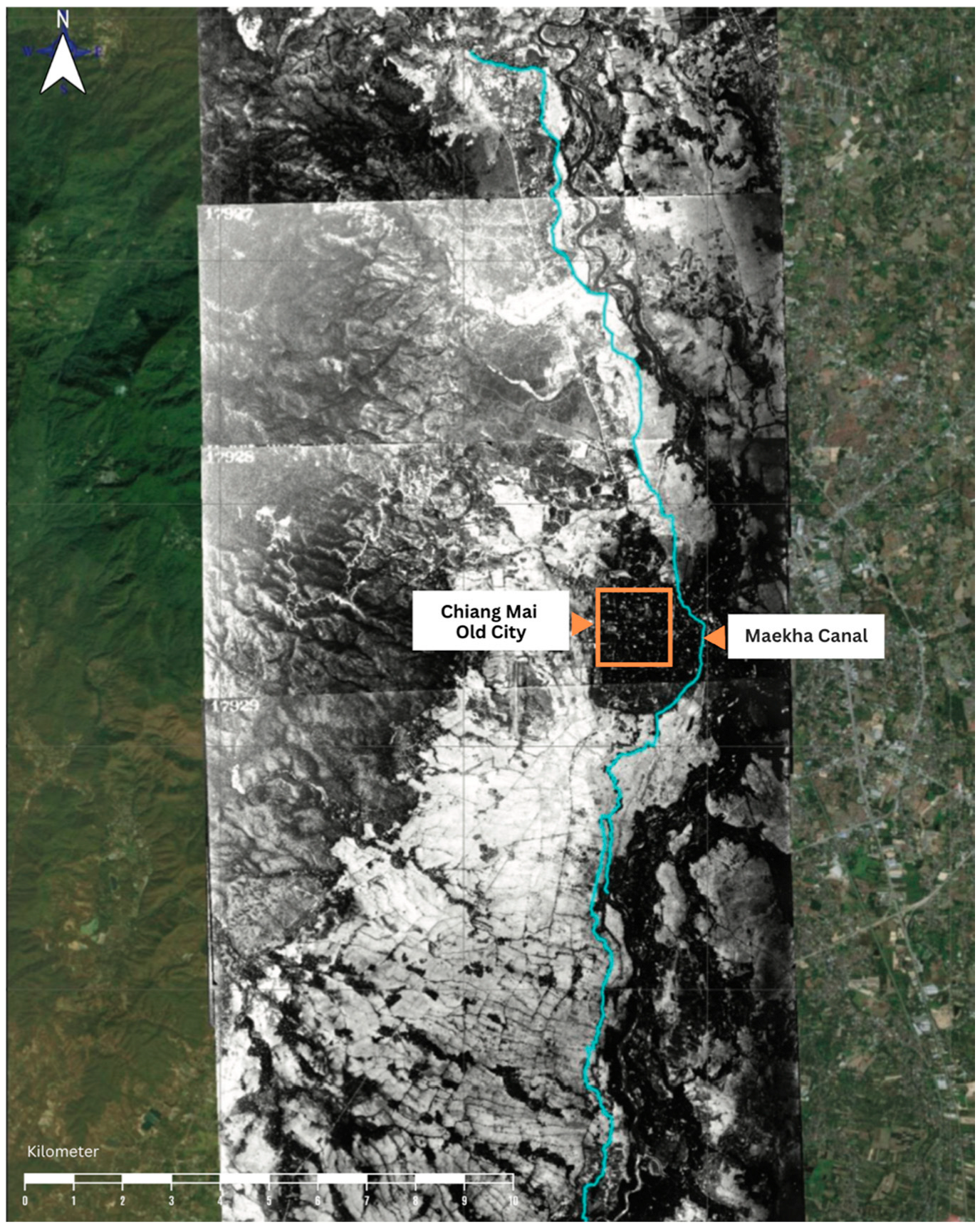
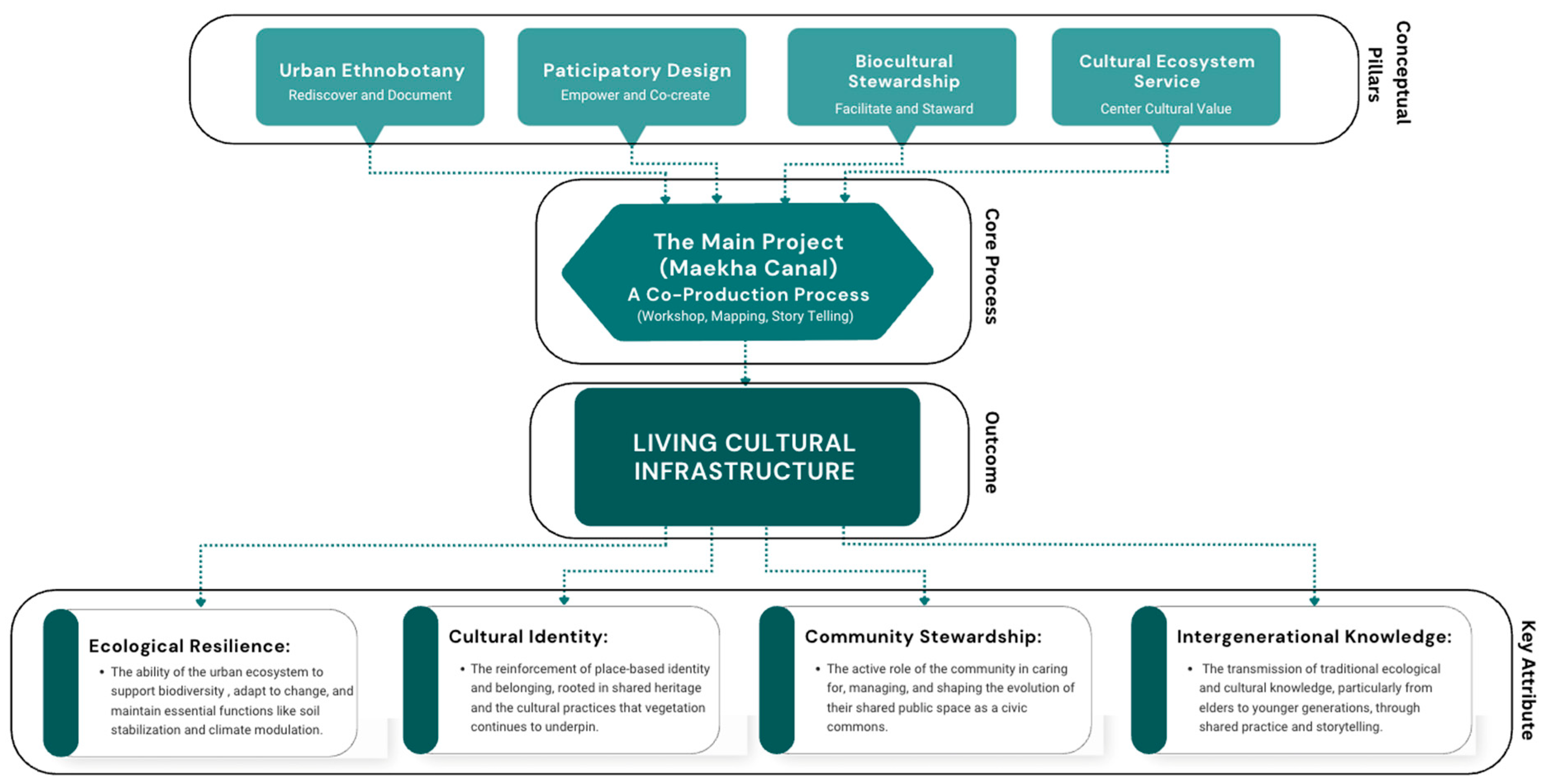
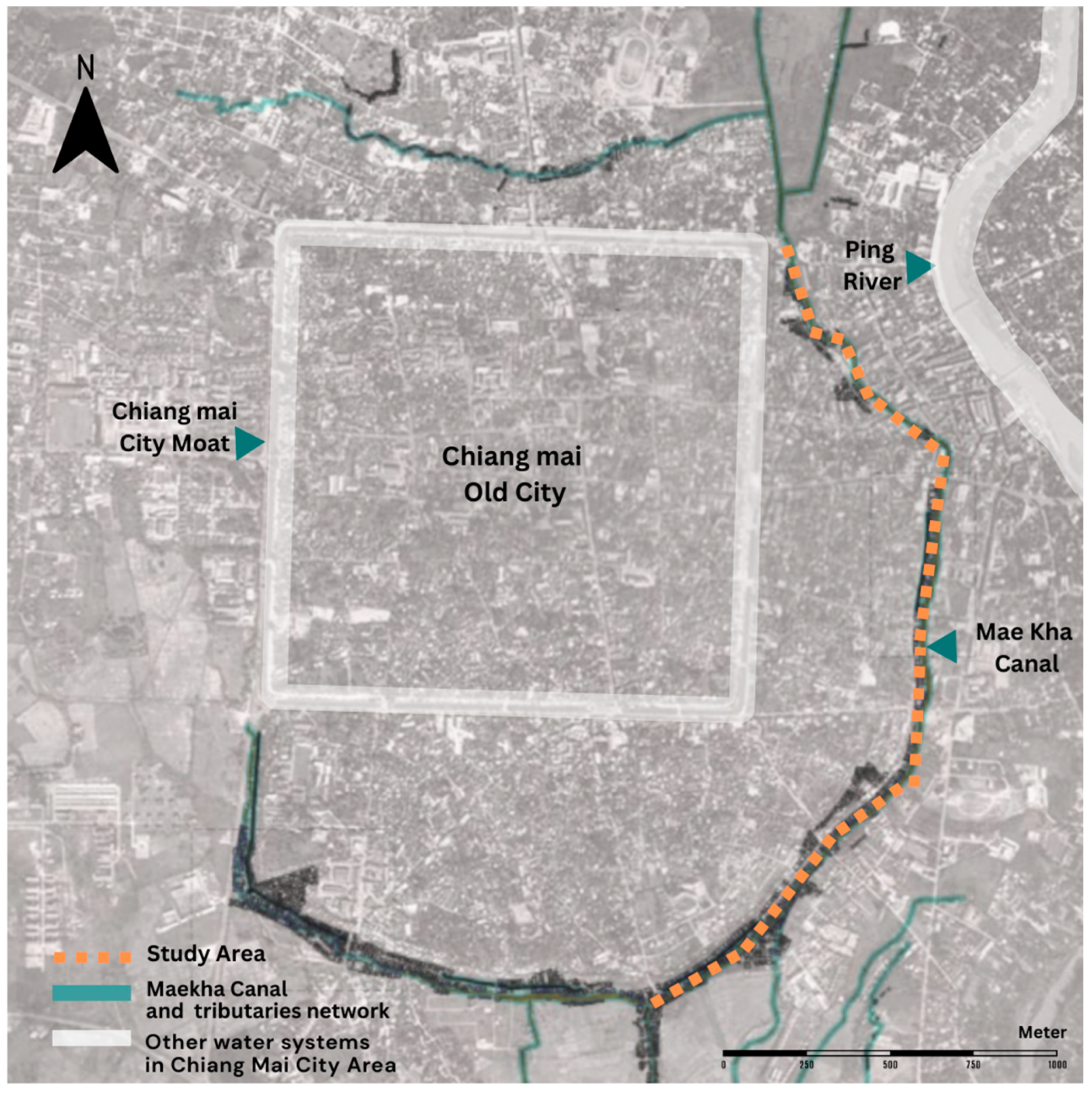

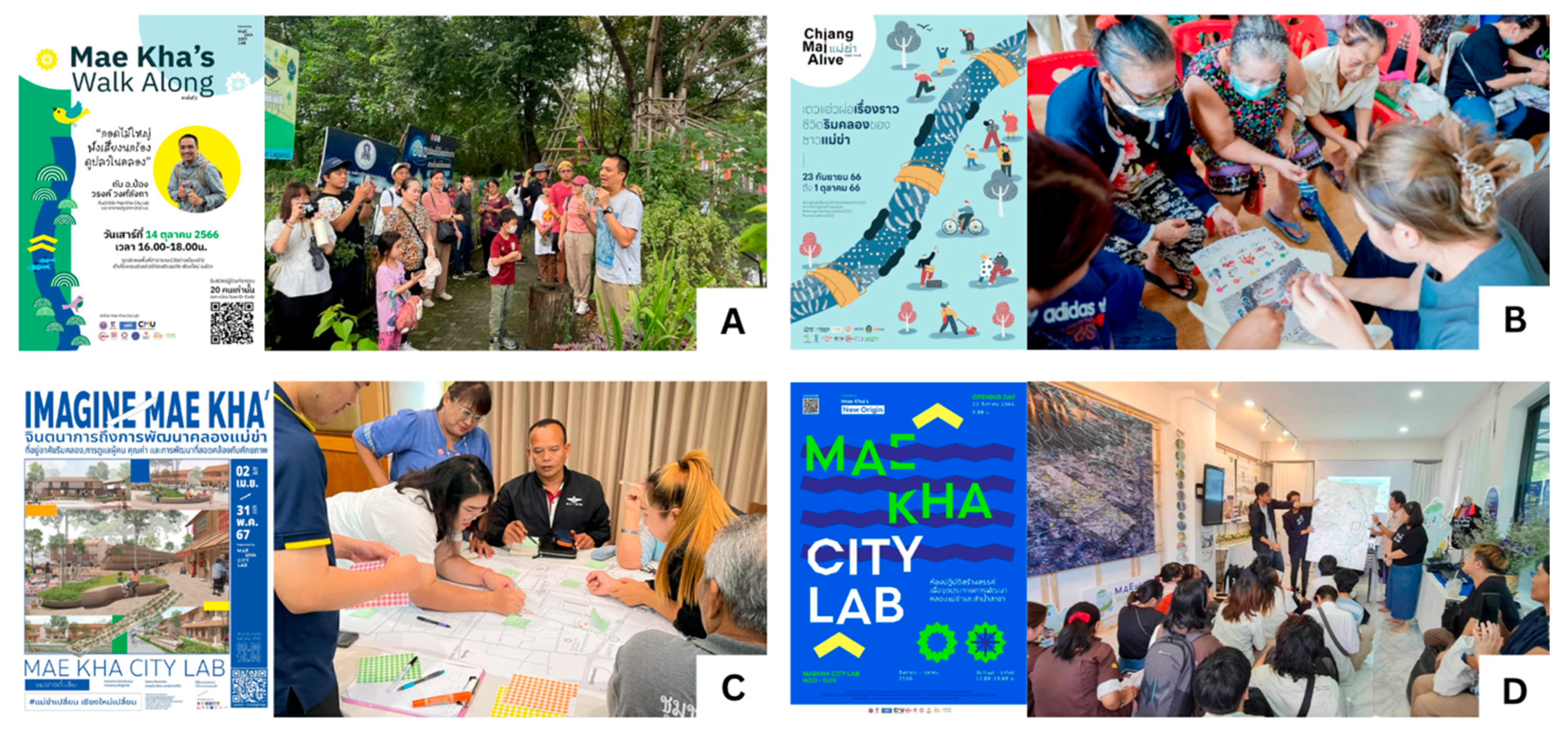
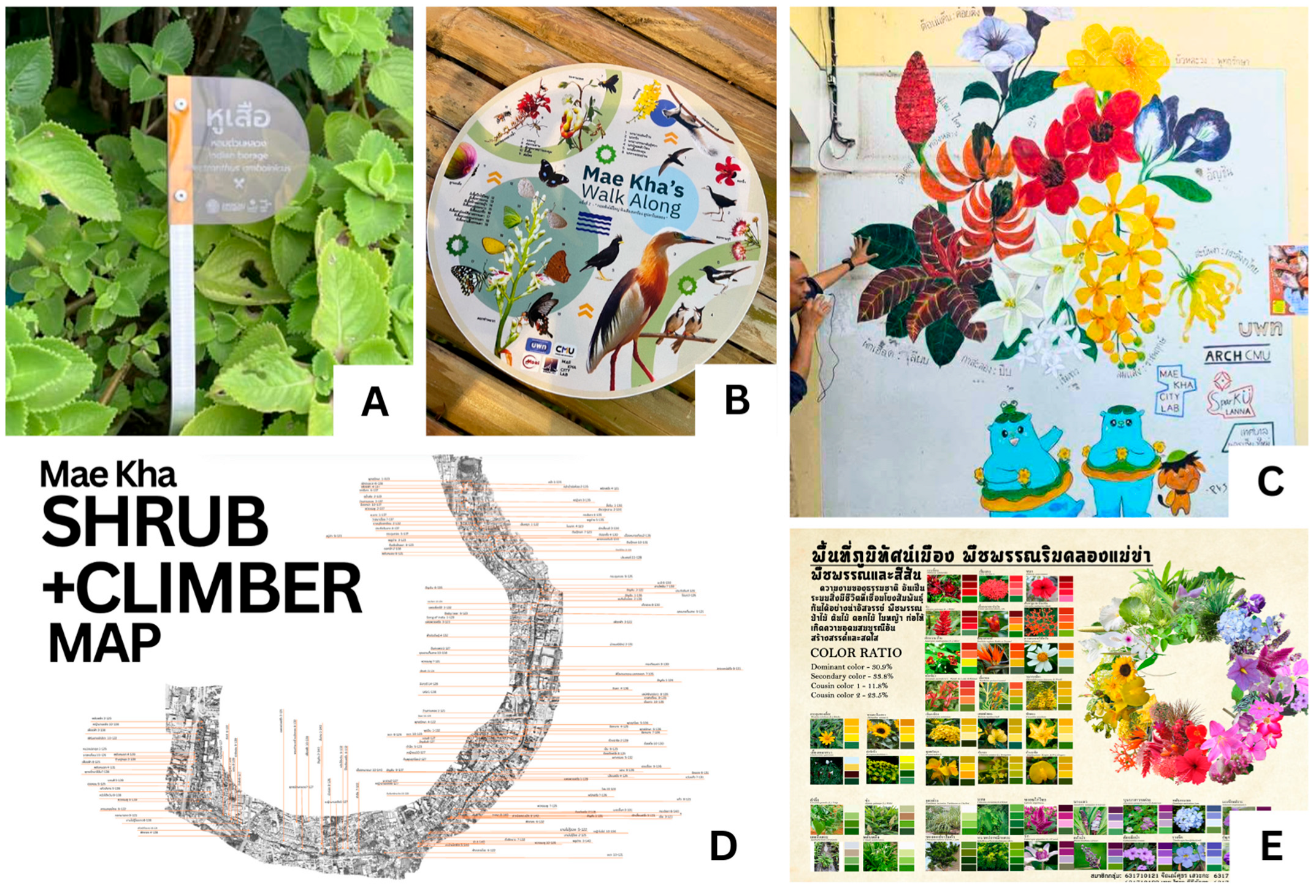
| Growth Form (Species) | Family | Number of Species | Growth Form (Species) | Family | Number of Species | Growth Form (Species) | Family | Number of Species |
|---|---|---|---|---|---|---|---|---|
| Tree (61) | MORACEAE | 12 | Shrub (56) | ACANTHACEAE | 6 | Climber | CUCURBITACEAE | 3 |
| FAB.CAESALPINIOIDEAE | 7 | ARACEAE | 5 | Plant (15) | ARACEAE | 2 | ||
| FABACEAE | 4 | ZINGIBERACEAE | 5 | BIGNONIACEAE | 2 | |||
| LECYTHIDACEAE | 3 | APOCYNACEAE | 4 | APOCYNACEAE | 1 | |||
| MELIACEAE | 3 | RUBIACEAE | 4 | CACTACEAE | 1 | |||
| RUTACEAE | 3 | EUPHORBIACEAE | 3 | CONVOLVULACEAE | 1 | |||
| ANNONACEAE | 2 | POACEAE | 3 | FABACEAE | 1 | |||
| BIGNONIACEAE | 2 | AMARANTHACEAE | 2 | MORACEAE | 1 | |||
| BOMBACACEAE | 2 | ASTERACEAE | 2 | PAPLIONIDEAE | 1 | |||
| COMBRETACEAE | 2 | CLEOMACEAE | 2 | PIPERACEAE | 1 | |||
| EBENACEAE | 2 | LAMIACEAE | 2 | POLYDONACEAE | 1 | |||
| EUPHORBIACEAE | 2 | AGAVACEAE | 1 | Aquatic | APIACEAE | 1 | ||
| LYTHRACEAE | 2 | AMARYLLIDACEAE | 1 | Plant (4) | MARANTACEAE | 1 | ||
| RHAMNACEAE | 2 | ARALIACEAE | 1 | PONTEDERIACEAE | 1 | |||
| SAPOTACEAE | 2 | ASCLEPIADACEAE | 1 | SCROPHULARIACEAE | 1 | |||
| ANACARDIACEAE | 1 | BORAGINACEAE | 1 | Ground | COMMELINACEAE | 2 | ||
| ARECACEAE | 1 | CANNACEAE | 1 | Cover (12) | LAMIACEAE | 2 | ||
| AVERRHOACEAE | 1 | COMMELINACEAE | 1 | PORTULACACEAE | 2 | |||
| BORAGINACEAE | 1 | CUCURBITACEAE | 1 | COMPOSIEA | 1 | |||
| CARICACEAE | 1 | CYPERACEAE | 1 | FABACEAE | 1 | |||
| CUPRESSACEAE | 1 | DRACAENACEAE | 1 | GESNERIACEAE | 1 | |||
| DRACAENACEAE | 1 | FABACEAE | 1 | LILIACEAE | 1 | |||
| LAURACEAE | 1 | GESNERIACEAE | 1 | PANDANACEAE | 1 | |||
| FAB.MIMOSOIDEAE | 1 | LYTHRACEAE | 1 | POACEAE | 1 | |||
| FSB.PAPILIONOIDEAE | 1 | MALPIGHIACEAE | 1 | URTICACEAE | 1 | |||
| MAGNOLIACEAE | 1 | MALVACEAE | 1 | |||||
| MALVACEAE | 1 | MARANTACEAE | 1 | Epiphytic | POLYPODIACEAE | 1 | ||
| MIMOSACEAE | 1 | NYCTAGNACEAE | 1 | Plant (1) | ||||
| MORINGACEAE | 1 | OLEACEAE | 1 | |||||
| MUNTINGIACEAE | 1 | PALMAE | 1 | |||||
| MUSACEAE | 1 | PANDANACEAE | 1 | |||||
| MYRTACEAE | 1 | PHYTOLACCACEAE | 1 | |||||
| PALMAE | 1 | PLUMBAGINACEAE | 1 | |||||
| PHYLLANTHACEAE | 1 | RUTACEAE | 1 | |||||
| SAPINDACEAE | 1 | SCROPHULARIACEAE | 1 | |||||
| VERBENACEAE | 1 | VERBENACEAE | 1 | |||||
| Total | 149 | Species |
| Engagement Activity | Description | Participants |
|---|---|---|
| Ethnobotanical Survey | In-depth semi-structured interviews and transect walks to document local plant knowledge, uses, and oral histories. | 20 key informants (community elders, healers, and gardeners aged 40–85). |
| Co-Design Sessions | A series of interactive workshops to co-develop the trail’s narrative, interpretive features, and spatial layout. | Broader community members, including local artisans, youth groups, and informal vendors. |
| Public Forums | A series of four public meetings to gather diverse insights, discuss challenges such as land tenure, and build consensus on the revitalization strategy. | Residents, business owners, and local stakeholders from different zones along the canal. |
| “Mae Kha Walk Along” Series | Publicly held themed walks along the canal to share knowledge about ecology and history, and to train community storytellers. | General public, residents, and community youth. |
| Household Prototypes | Co-development of prototypes for household-level green space and wastewater management. | 80 households from the canal-side communities. |
| Traditional Role (Top–Down Model) | Evolving Role (Co-Production Model) |
|---|---|
| Master Planner: acts as a top–down planner who views the community as a subject of design, rather than a co-author. | Facilitator of Community Memory: creates processes (e.g., workshops, storytelling) to surface and weave localized knowledge and community memory into the design, e.g., conducting ethnobotanical interviews with 20 community elders and establishing the “community storyteller” program. |
| Technical Expert: operates primarily as an expert, prioritizing professionalized or scientific knowledge over local and embedded wisdom. | Curator of Living Heritage: selects and arranges biocultural elements (plants, materials, narratives) to preserve living heritage and make it accessible and meaningful, e.g., curating the 149 documented plant species and their narratives into the trail’s learning points, botanical signage, and the Mae Kha Vegetation Map. |
| Designer of Form and Aesthetics: focuses on the final aesthetic outcome and ecological function, often detached from the deep cultural context and social meaning. | Co-producer of Civic Space: shares agency and decision-making power with the community to collectively shape public space and its ongoing meaning, e.g., engaging residents, youth, and artisans in co-design sessions to determine the trail’s spatial layout and interpretive features. |
| Works within “Invited” Spaces: operates within formal, pre-defined spaces of participation that are structured by institutions. | Nurtures “Invented” Spaces: recognizes and supports organic, community-led spaces of participation that emerge from grassroots initiatives and resistance, e.g., structuring the project to build upon and provide resources for the pre-existing, grassroots “Imagine Maekha” initiative. |
Disclaimer/Publisher’s Note: The statements, opinions and data contained in all publications are solely those of the individual author(s) and contributor(s) and not of MDPI and/or the editor(s). MDPI and/or the editor(s) disclaim responsibility for any injury to people or property resulting from any ideas, methods, instructions or products referred to in the content. |
© 2025 by the authors. Licensee MDPI, Basel, Switzerland. This article is an open access article distributed under the terms and conditions of the Creative Commons Attribution (CC BY) license (https://creativecommons.org/licenses/by/4.0/).
Share and Cite
Wonglangka, W.; Suwannarat, S.; Auttarat, S. Living Cultural Infrastructure as a Model for Biocultural Conservation: A Case Study of the Maekha Canal, Chiang Mai, Thailand. Conservation 2025, 5, 45. https://doi.org/10.3390/conservation5030045
Wonglangka W, Suwannarat S, Auttarat S. Living Cultural Infrastructure as a Model for Biocultural Conservation: A Case Study of the Maekha Canal, Chiang Mai, Thailand. Conservation. 2025; 5(3):45. https://doi.org/10.3390/conservation5030045
Chicago/Turabian StyleWonglangka, Warong, Samart Suwannarat, and Sudarat Auttarat. 2025. "Living Cultural Infrastructure as a Model for Biocultural Conservation: A Case Study of the Maekha Canal, Chiang Mai, Thailand" Conservation 5, no. 3: 45. https://doi.org/10.3390/conservation5030045
APA StyleWonglangka, W., Suwannarat, S., & Auttarat, S. (2025). Living Cultural Infrastructure as a Model for Biocultural Conservation: A Case Study of the Maekha Canal, Chiang Mai, Thailand. Conservation, 5(3), 45. https://doi.org/10.3390/conservation5030045






